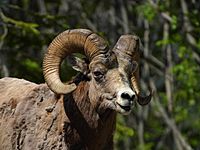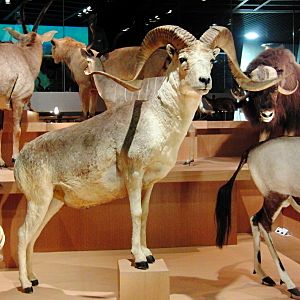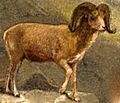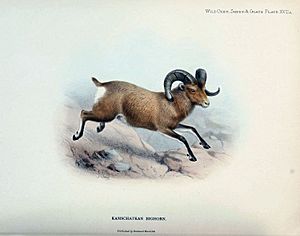Ovis facts for kids
Quick facts for kids Sheep |
|
|---|---|
 |
|
| Bighorn Sheep | |
| Scientific classification | |
| Kingdom: | |
| Phylum: | |
| Class: | |
| Order: | |
| Family: | |
| Subfamily: | |
| Genus: |
Ovis
Linnaeus, 1758
|
Ovis is a group of animals that includes wild sheep, domestic sheep, and other similar creatures. These animals belong to the Caprinae family, which also includes goats. There are five or more different kinds of sheep in this group.
Contents
What Makes Sheep Special?

Sheep are not very large compared to other hoofed animals. Most adult sheep weigh less than 100 kilograms (about 220 pounds). Male sheep, called rams, are usually much heavier than females, which are called ewes.
Wild sheep mostly live in hilly or mountainous places. They mainly eat grasses, but also other plants and lichens. Like other ruminants, sheep have four-part stomachs. This helps them digest their food. They can bring up partially digested food, called cud, to chew it again. This allows them to get nutrients from tough plant materials. Sheep are also good at saving water, so they can live in dry areas.
Their Amazing Coats
Wild sheep and some domestic sheep breeds have thick coats of hair. This coat protects them from the cold. It has long, stiff hairs called kemps over a soft, woolly undercoat. This undercoat grows in autumn and falls off in spring.
Many domestic sheep breeds have been specially bred for their wool. Their soft undercoat has grown into a long, thick woolly fleece. This fleece covers their body, and sometimes their face and legs. People use this wool to make fibre for clothes and other items. Domestic sheep are also raised for their milk and their meat, which is called mutton or lamb.
Horns and Senses
In wild sheep, both rams and ewes have horns. For domestic sheep, it depends on the breed. Some have horns, some only have them on rams, and some have no horns at all.
Rams' horns can be very big. The horns of a grown Bighorn sheep ram can weigh 14 kilograms (about 31 pounds). That's as much as all the other bones in its body combined! Rams use their horns to fight each other. They do this to show who is strongest and gets to mate with the ewes. Usually, they don't get hurt because they hit each other head-to-head. Their curved horns don't hit their bodies. They also have very thick skin and skulls with two layers, which protects them.
Wild sheep have excellent sight and hearing. When they spot a predator, they usually run away. They often run uphill to higher ground. But they can also fight back. For example, the Dall sheep has been known to push wolves off cliffs!
Sheep also have special scent glands on their faces and feet. Scientists don't fully understand how they use these glands to communicate. But they think it's important for finding mates. Male sheep can smell when females are ready to have babies. Rams also mark their areas by rubbing their scent on rocks.
Main Types of Sheep
Here are the main types of Ovis sheep:
 |
Ovis ammon | Argali |
 |
Ovis orientalis aries | Domestic sheep |
 |
Orientalis orientalis orientalis group | Mouflon |
 |
Ovis orientalis vignei group | Urial |
 |
Ovis canadensis | Bighorn sheep |
 |
Ovis dalli | Dall sheep |
| Ovis nivicola | Snow sheep |
Images for kids
See also
 In Spanish: Ovis para niños
In Spanish: Ovis para niños



